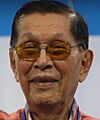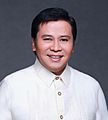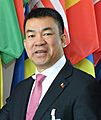President of the Senate of the Philippines facts for kids
Quick facts for kids President of the Senate of the Philippines |
|
|---|---|
|
Incumbent
vacant since June 30, 2025 |
|
| Style | Mr. President (informal; within the Senate) The Honorable (formal) His Excellency (formal, diplomatic) |
| Member of | Senate of the Philippines National Security Council Commission on Appointments |
| Reports to | Senate of the Philippines |
| Seat | GSIS Building, Pasay |
| Appointer | The Senate |
| Term length | At the Senate's pleasure |
| Inaugural holder | Manuel L. Quezon |
| Formation | October 16, 1916 |
| Succession | Second |
| Website | Senate |
The President of the Senate of the Philippines, often called the Senate President, is a very important leader in the Philippine government. This person is the main officer and highest-ranking official in the Senate of the Philippines. They are also the third most powerful official in the entire government.
The Senate President is chosen by all the senators to be their leader. They are also second in line to become president of the Philippines, right after the Vice President and before the Speaker of the House of Representatives.
The last Senate President was Francis Escudero. He was chosen on May 20, 2024, and his term ended on June 30, 2025. The position is currently vacant.
Contents
How the Senate President Is Chosen
The Senate President is elected by a majority of the senators themselves. Since there are 24 senators, at least 13 votes are needed to become Senate President. This includes any seats that are empty or senators who are not there during the vote.
Even though a new Senate President is usually chosen at the start of each new Congress, there have been times when a Senate President was replaced in the middle of their term. Sometimes, senators who both want the job agree to share the term. This has happened twice, in 1999 and 2006, allowing for a smooth change in leadership.
Unlike in some other countries where the Senate President mostly just leads meetings, the Senate President in the Philippines has a lot of power. They can influence what laws the Senate works on. They can also vote on laws, but they usually vote last. If there's a tie vote, the motion (the idea being voted on) is lost, and the Senate President cannot vote again to break the tie.
What the Senate President Does
The Senate President has many important jobs and responsibilities. Here are some of them:
- They lead the Senate meetings at the right times.
- They make sure the rules are followed during discussions.
- They sign all official documents, like laws and resolutions.
- They can issue orders for arrests or to make people provide documents for investigations.
- They make sure that all decisions made by the Senate are followed.
- They are in charge of the Senate hall, offices, and other areas.
- They keep order in the Senate building and can take action if there is trouble.
- They can choose someone to act as the sergeant-at-arms if needed.
- They hire staff for the Senate, following the rules.
- They can fire employees for good reasons, following civil service laws.
- They can change the number of staff members if allowed by the budget.
The Senate President is also the leader of the Commission on Appointments. This is a special group in Congress that has the power to approve or reject people the president of the Philippines chooses for important government jobs. As the chairman of this commission, the Senate President also:
- Calls meetings for the commission.
- Leads the meetings of the commission.
- Keeps order during the commission's sessions.
- Makes decisions on questions about rules, though members can challenge these decisions.
- Carries out the decisions and orders made by the commission.
If other high-ranking officials, like the ombudsman, are on trial for impeachment (being removed from office), the Senate President leads that trial. They are also the last person to vote on the decision in such cases.
In the Senate, the Senate President also oversees the different committees. They can attend committee meetings if needed, and all committee reports are sent to their office.
Past Senate Presidents
Since 1941, all senators in the Philippines have been elected by voters from all over the country. Many important leaders have served as Senate President. The first was Manuel L. Quezon, who held the position for many years starting in 1916. After him, leaders like Manuel Roxas, José Avelino, and Mariano Jesús Cuenco took on the role.
Over the years, the Senate President has been held by various individuals from different political parties, including the Nacionalista Party, Liberal Party, and others. Some individuals, like Eulogio A. Rodriguez Sr. and Franklin Drilon, served multiple times. The role has seen many changes, including periods when the Senate was abolished or its functions were taken over by the president during different times in Philippine history.
The most recent Senate President was Francis Escudero, who served until June 30, 2025.
Images for kids





























